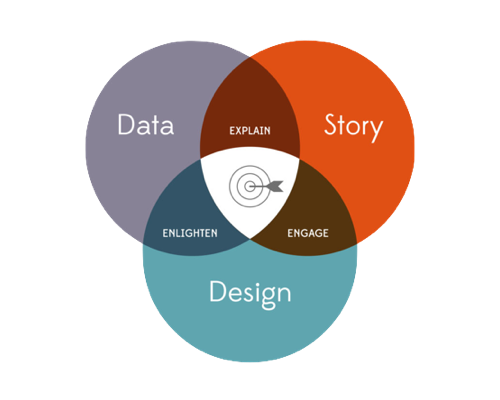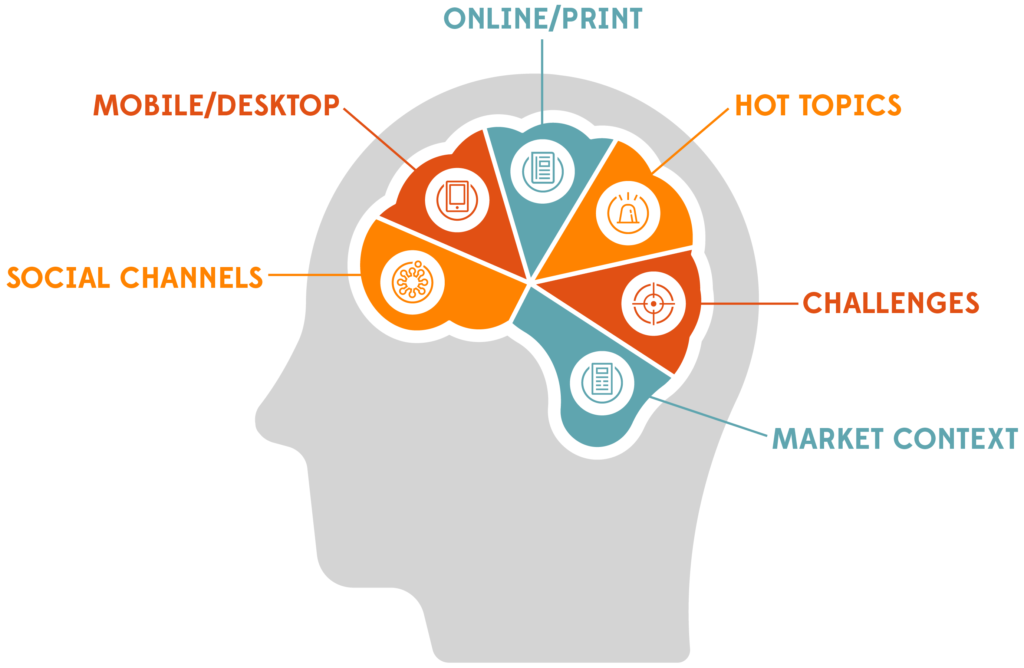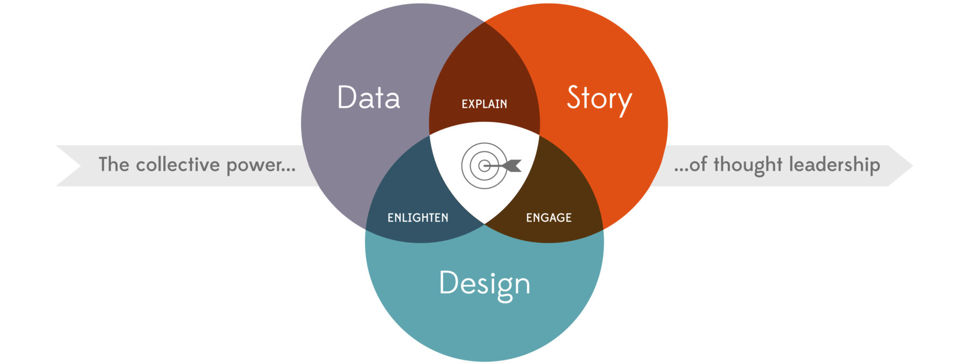B2B content marketing: A practical guide
A practical guide for how B2B brands can use content marketing to better engage audiences throughout the buyer journey
Content has become a critical tool in the marketing mix for almost every B2B brand. Nine out of ten B2B marketers are using content marketing strategies to pull in new customers. In 2019, the most successful marketers were already spending 40% or more of their budget on their content strategy.
“The real power only comes to those who can create content that connects, engages, and moves through the network.”So why aren’t more marketers getting the content marketing ROI they are looking for? Let’s start with the basics.Mark Schaefer
What is B2B content marketing?
 At its simplest, B2B content marketing is when a brand uses stories, ideas and insights to engage and influence a business audience.
At its simplest, B2B content marketing is when a brand uses stories, ideas and insights to engage and influence a business audience.
By telling powerful stories, the best content marketers ensure their companies get noticed by audiences that are tired of conventional product-led or salesy marketing.
Through sharing new ideas, these content marketers are able to inspire and inform their customers – helping them see their business problems in a new light, or to take a fresh perspective on the trends reshaping their market.
The best content marketing campaigns back up these stories and ideas with robust insights: interesting data points, original research and real-world examples that help their customers understand a new trend or challenge and equip them with the tools and best practices to respond and thrive.
The benefits of content marketing
Content marketing is a powerful tactic because of the way it increases exposure to your brand across multiple channels. Just one outstanding piece can have a significant commercial impact.
The inbound leads that result from a good content marketing campaign typically require far less time and effort in comparison with traditional outbound marketing activities.
Better still, by educating people about what you have to offer, your content effectively pre-qualifies prospects, so that when they are ready to connect, they have already begun their buying journey without your explicit intervention.
This is the best kind of marketing. Because for your customers, it doesn’t really feel like marketing at all.
If your content has quality then you will also establish your authority and create distinctiveness for your brand in a competitive market.
Since B2B sales can take months to conclude, good content also helps maintain engagement by keeping you in the buyer’s eye-line. If you create content that consistently addresses the audience’s interests and needs, you can nurture customer relationships to the point when they are ready to purchase.
Creating a content strategy
Content marketing and storytelling
Everyday B2B companies bombard audiences with new content delivered across every conceivable channel: reports, e-books, infographics, videos, podcasts, the list goes on and on.
Given this volume, it takes something rare and special to make a business leader stop and take notice of what you have to say, so the bulk of this content passes unnoticed by its intended audience.
 So where should you start building your content marketing plan?
So where should you start building your content marketing plan?
The secret of great B2B content is to focus on the combination of stories, ideas and insights as these are the building blocks of all great content marketing campaigns.
Business audiences respond to an idea that surprises or inspires them. They value insight that reframes the way they think about a particular business issue. And, like all human beings, they engage with and remember stories they can connect with at a deeper level.
Of course, you must also have the right strategy and appropriate channels through which to reach and convert your audiences. B2B content marketing strategies are wide-ranging, but most marketers will need to choose a select few in order to get the right level of results. Content marketers also need to master a wide range of formats, from traditional articles and reports to engaging videos, podcasts, case studies and data visualisations. Always remember: if there’s no story, there will be little engagement.
B2B Buyer personas
Why are buyer personas so important?
One of the biggest mistakes many content marketers make is in failing to understand their buyers’ needs and interests. Just knowing gender, age and interests, though useful information, is not enough from a content creation perspective. You have to go much deeper if you want your content to resonate.
Many B2B marketers know very little about their customers’ needs, because they never ask them. Only around four in ten regularly talk to their customers about what they want.
Unless you understand how your customers prefer to consume content, you are likely to miss the mark or end up pursuing a one-size-fits-all approach.
As preferences can vary from one individual to the next, you need to think about creating a choice of channels and formats to reflect the diversity in how different customers prefer to consume content.

Take the ‘C-suite’, for example. If you view and cater to this audience as a homogenous group of buyers, your content marketing will almost certainly be ineffective because it’s very unlikely to reflect the different corporate interests of CEOs, CFOs, COOs and CMOs. Nor is it likely to address how, as individuals, they choose to access content.
To truly connect with such an audience, think about building not just one but multiple buyer personas and then creating different content types to reflect this diversity. Your audience, for example, may be made up of ‘skimmers’, ‘waders’ and ‘deep divers’ of content, some of whom will prefer video to a podcast, short articles to long ones, or reading at their desks rather than to listening during their morning commute. Be sure to service them all and give them every opportunity to engage.
Types of content marketing
What types of content are most effective for B2B audiences?
In our experience, the types of content that typically attract potential buyers include formats such as:
- Blog posts – marketers who make blogging a priority are 13x more likely to see a positive ROI for their efforts.
- White papers – favoured by 22% of business leaders, these longer research based reports provide more in-depth information. Learn more about writing a compelling B2B marketing white paper here.
- Shorter articles – enjoyed by 37% of execs, these have to be research based if they are to stand out.
- Case studies – these provide buyers with reassurance further down the buying funnel and can be made sector-specific. Nearly half of all business leaders appreciate them.
- Infographics – these have become one of the most popular content marketing tools in recent years.
- Podcasts – increasingly popular lead generation tools with marketers looking to deliver thought leadership content to buyers on the move.
- Videos – companies using video, experience clickthrough rates that are 27% higher and web conversion rates 34% greater than those that don’t.
- Email – nearly eight out of 10 marketers report seeing an increase in email engagement over the past 12 months.
- LinkedIn – generates more than 50% of all social traffic to B2B websites & blogs.
Every format has its advantages and disadvantages. And there are many more you could use, depending on what is right for your buyers and your brand.
Content planning
How can you come up with a winning B2B content marketing plan?
Interesting stories, ideas and insights are the fuel that drives a good brand’s content marketing strategy. But how do you find the right topics and ideas? Here are some suggestions:
- Run a content workshop to identify potential angles. To avoid ‘group think’ make sure you invite more than the ‘usual suspects’. Include representatives from a cross-section of different departments.
- Talk to your frontline staff, your sales and customer service teams, and account managers. They are the ones who are likely to pick up on useful feedback from your buyers that could be turned into a content idea.
- Listen to the conversations on social platforms using tools like Buzzsumo. This will help you discover the questions your target audiences want answering.
- Ask your customers directly about their biggest challenges, then develop content that provides them with solutions.
- Subscribe to newsfeeds, as these will reveal the topical trends you could tap into for content ideas.
- Look at what your competitors are writing about and then identify and exploit the white space they aren’t covering with their content.
However you choose to gather ideas for your content, always think beyond the obvious. And if you don’t believe you have anything original or different to say, then work harder to find it – or investigate employing a content marketing agency to uncover it for you. Their creative skills, journalistic talents and third-party perspective can make a significant difference when it comes to finding unique content angles that will capture and engage your audience.
Focus on informative content
Creating good content isn’t about producing more of the same. Adding to the piles of mediocre content will certainly not make your brand stand out. In fact, poor quality content will reflect badly on your business, diminishing your authority and lowering trust with your buyers – the very opposite of what you want.
To cut through the noise, give your content added value by selecting, then enhancing and repackaging the most useful insights so as to tell a ‘story’ that people will remember.
Creating great content is not a mere process of transcribing reality, you need to find ways to add colour, variety, or a unique spin that will humanise the ideas within it.
This makes storytelling – which appeals to emotion as much as logic – an essential element of good content, even in the hard-nosed world of B2B.
Thought leadership content marketing
Using thought leadership content effectively is one of the most powerful B2B strategies around with nearly 60% of business decision makers saying that it’s directly led to them awarding business to a supplier.
However, FT Longitude’s own research for our The power of thought leadership survey reveals that much of the time, thought leadership content offers little in the way of interest or insight.
Primarily the vast majority repeats what others have said rather than saying anything new. So rather than being memorable, it becomes instantly disposable.
To be a thought leader in your field, you must be doubly focused on creating value for your prospects and customers. That means producing informative and engaging content that’s built around imaginative storytelling and original ideas.

Keep in mind that creating such content doesn’t have to be directly related to an innovative product or solution. It could present your unique perspective on a relevant broader topic or area of expertise. Taking this approach has enabled many companies to carve out their own distinctive voice and niche in the market.
One of the most effective ways to achieve this is to invest in research that produces fresh insights that resonate with your target audience. If you can distil this thinking down into a range of content assets that meet your market’s needs, then you’re onto a winner.
For example, global Insurance firm Allianz has become linked with its Risk Barometer; while management consultancy McKinsey & Company is strongly associated with diversity and board performance; and search agency Moz has made Whiteboard Fridays famous.
B2B content marketing strategy
Why is a content marketing strategy so important?
Effective content marketing can deliver dramatic results, generating up to three times more leads than paid search advertising. But achieving such results requires a sound content marketing strategy – and there are challenges. Read this summary to find out how to overcome some of the most common challenges.
But, a successful content marketing strategy will help to ensure that you:
- develop multiple buyer personas for those you want to reach
- create content that speaks to their needs, and
- choose the best delivery channel, and consequently content format, to reach them.
Though content marketing can deliver rapid results – remember, all it takes is for one piece of content to capture the market’s attention – it is generally an incremental process that involves prospects taking multiple steps before becoming a customer.
Be happy at first to gain five seconds of someone’s attention through some snackable content. Then when you’ve achieved that, aim for ten seconds more, and then a minute. If you can hold that attention for three to five minutes, then you have a chance to convert. Trying to move too fast will leave potential buyers feeling pressured and out of control – which is counterproductive.
Even when you have gained their trust, be respectful by not making assumptions or taking anything for granted about their needs. Once you have gained a reputation for delivering high quality content, never short-change your audience by giving them anything less. If you do, then you will be in danger of damaging your relationships with them forever. However, if you can keep serving their needs and presenting them with new ideas, they can develop into brand advocates.
So be patient. Be consistent. Be respectful. These are all important things to keep in mind when developing your content strategy.
Promoting your content
Why is content activation critical to success?
Content marketing is not just about creating the content, it’s also what you do with it that matters. Consider for a moment that in most B2B organisations around 60 to 70% of all marketing content is never used by its sales reps.
That means if you want to squeeze the most value out of your content, you have to ‘activate’ to ensure those who would find it useful – both inside and outside the organisation – are made aware of its existence.
Having a content activation plan in place enables you to maximise use of your content by bringing it to the attention of your marketplace through multiple channels.
Email marketing
Email nurture campaigns are one way to do this – over 90% of B2B marketers use email to distribute content. Customised email campaigns, based on audience data and behavioural analytics, will introduce prospects to your content in a more informed and useful way, meaning they are more likely to either request or be open to receiving more.
Marketing automation
The use of marketing automation systems like Hubspot, Pardot or Marketo also help ensure content doesn’t stay locked away in silos, by seamlessly serving your prospects with the optimal piece of content when they need it. Using such marketing technology will also give you a range of valuable KPIs that remove any guesswork when evaluating what is or isn’t working with your content. This will help focus valuable time and resources on developing content that makes an impact.
Social media
Social media will increase the reach of your content too, helping amplify your message and creating new opportunities for audience engagement. With a clear strategy in place, you can then use influencer marketing to turn your social media followers from passive observers and occasional engagers into brand evangelists.
Paid promotional channels
With the effectiveness of organic search across social media platforms being called into question, more B2B marketers are now using paid promotional channels such as paid social media, search engine advertising, native advertising, digital outreach and programmatic display to extend their reach.
Using digital PR to extend your influence
Digital tools can help to strengthen your online relationships with audiences, as well as generating opportunities for non-paid link citations, both of which help activate content and improve perceptions of authority. Digital PR tactics, such as using content to influence online journalists, specialist writers and website owners in exchange for quality backlinks that increase the visibility of your content, will help to raise your profile and demonstrate your knowledge and expertise.
Read more about putting PR at the core of your thought leadership strategy here.
Measuring content marketing ROI
To gauge the success of your content marketing efforts, you need to measure its return on investment (ROI). At a basic level, a simple calculation considers the cost of producing and distributing content against the value of sales generated from that content.
Unfortunately, there isn’t always a clear line of sight between content and revenue. This challenge requires us to take into account some less obvious metrics, such as number of backlinks from a particular blog post to your site, your website’s domain authority, exposure metrics like share of voice, the number of downloads your content achieves, or the volume of email enquiries going through to your sales team.
You can also track your social media shares with tools such as Buzzsumo. This is important because if people are finding your content valuable enough to share with others, then you know it has value. And those shares will be expanding your reach and building your reputation, which together will generate more leads – and ultimately sales.
Monitoring coverage in respected media outlets, both trade and general press, radio and television, will also give you an indication of your content marketing success, particularly if you are looking to reach new audiences. The more “offline” exposure your content yields, the more you will be regarded as an authority in your field.
For most companies, one of the primary purposes of content marketing is to increase traffic to your website. Your website is the best place to direct audiences to in order to find out more about the products and services – or better known as solutions – you offer. Google Analytics will help show how traffic is flowing to and through your site. It will also tell you the source. Knowing which sources are driving most traffic enables you to adjust and refine your approach.
Content marketing isn’t just about driving potential buyers to your website though, it’s also about getting them to stay longer once they are there. Another important metric to track is bounce rate. To ensure a low bounce rate, make sure that the content your visitors find is of the highest quality and will add value.
In-house content creation
If you decide to create your content in house, it’s important to have a team in place that has the journalistic, design, creative and technical skills necessary to produce the content assets. But be sure to assign an owner to the content programme overall – someone who has final responsibility for making sure things stay on track, and that all relevant skills are being applied to each and every piece that’s created.
Next you need to establish a process for identifying and gathering ideas, and then create a set of criteria for prioritising the best ones to move forward.
Ideas for content can come from many places, so consider soliciting your entire company’s workforce as a possible source for viewpoints. Employee-generated content highlights the efforts of those who work in your organisation and gives your content an authentic quality that will only increase trust in your brand.
Outsourcing content marketing
What to look for in a B2B content marketing agency
For many organisations, outsourcing their content marketing efforts to an outside agency is a more practical, efficient and less resource-intensive option.
It also helps to ensure the job gets done. If content is going to play a major part in your marketing strategy, then it needs to be produced and distributed consistently and at scale. If you don’t have a dedicated team or staff in place with time to do this, then people’s ‘day jobs’ can tend to take precedence over generating your high-quality content.
The right external agency is also likely to be able to supplement your existing skill sets, by adding strategy, research, design and other creative and technical skills to the process, which may not be readily available in your team. There’s also a strong chance that you will benefit from the cross-fertilisation of ideas, gleaned through their experience of working with other related organisations.
A final word on B2B content marketing
By cutting the cost of creating and distributing ideas, the internet substantially increased the potential returns from content marketing, which is why companies are now investing so heavily in it.
However, to maximise returns on that investment, marketers need to be certain that they are producing the high-quality, value-added content that addresses their buyers’ needs. Without it, you will only be adding to a mountain of vanilla content that does nothing for your business.
Remember, behind every piece of bad content is the executive who asked for it – make sure you are never the one who commissioned it.
Sign up to the newsletter
We help organisations stand out, speak with authority and spark inspiration, so change can happen. That’s real intelligence with influence. Sign up to our newsletter to get regular updates.
Subscribe






 Back
Back

 Book a meeting
Book a meeting
 Book a meeting
Book a meeting




